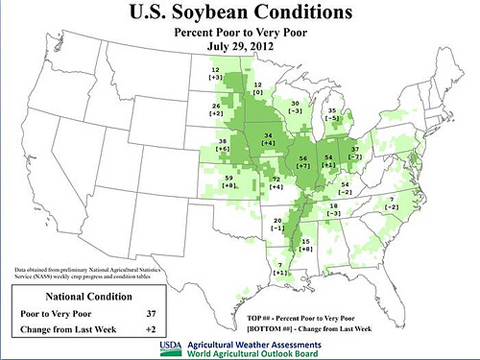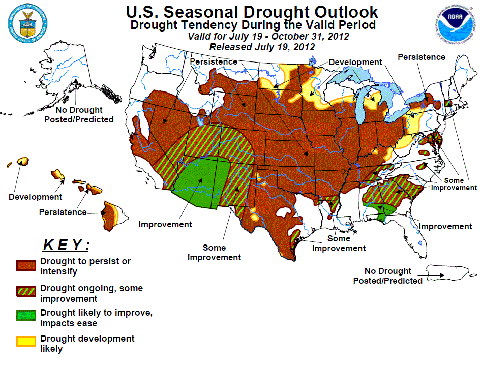Grain Markets Soar On Worldwide Crop Downgrades
By Naomi Spencer
01 August, 2012
WSWS.org
Downgraded harvest outlooks in the US, Russia and Australia sent grain markets soaring upward Monday. As US crops wither under the most severe drought and heat wave in more than half a century, droughts in Canada and the Black Sea growing region, a below average Indian monsoon, and a massive downgrade of the Australian wheat harvest threaten a global food crisis.
For the eighth consecutive week, the US Department of Agriculture (USDA) on Monday reported a deterioration in the nation’s corn crop.
As of the week ending July 29, less than one quarter (24 percent) of US corn is considered in “good” or “excellent” condition, down from 77 percent in mid-May. Only 3 percent of the corn crop across 18 states surveyed was rated as “excellent.”
Soybeans were also once again downgraded, with 29 percent in good or excellent condition and 37 percent in the worst categories. These ratings are the worst since the drought of 1988, which devastated the rural economy and forced thousands of smaller farmers out of business.
There are no signs that the drought or heat wave will ease in the coming weeks before soybean harvest. Across the southern corn belt, high temperatures will continue to approach 110°F, USDA meteorologist Brad Rippey said Monday.

This area, encompassing Missouri, southern Illinois and Indiana, is a major center for grain crops as well as livestock production. Little to no rain has fallen for months in the region, and temperatures have consistently averaged 5° to 10°F above normal. Worldwide, the past weeks have seen the hottest land temperatures ever recorded.
The damage to the US corn crop sustained during the critical pollination stage last month is now irreversible. More than two-thirds of corn acreage in major agricultural states Illinois and Indiana were rated as “poor” or “very poor.” Throughout the Midwest as a whole, 48 percent of the corn crop is similarly rated.
A rating of “very poor” means that the plants will yield little to no corn. In Vermillion County, Indiana, for example, farmers have estimated some acreage will yield only 14 bushels of corn per acre. The USDA officially projects an average yield of 146 bushels an acre.
The US produces one of every three tons of corn, soybeans and wheat traded globally.
“It is a disaster this year in the Midwest and I think that we need to start talking about disaster-type yield losses,” Des Moines, Iowa-based Freese-Notis Weather meteorologist Craig Solberg said in an interview with Agriculture.com. “In my mind this may mean a national corn yield below 120 bushels per acre (and maybe a national corn crop below 10 billion bushels) and a national soybean yield below 36 or even 35 bushels per acre.”
Other recent estimates by private firms of 120 bushels an acre have fueled a buying frenzy of corn futures on the Chicago Board of Trade. On Tuesday morning, corn for September delivery surged to $8.2425 a bushel. The price represents a 28 percent increase over the month—the largest one-month gain in more than five years. Soybean and wheat prices are also spiking upward on speculation.
“Global attention remains fixed on the state of the US corn crop,” Rabobank analyst Erin FitzPatrick said in a statement. “Hope is now starting to run out that we will see any improvement in the US corn crop and the bulk of the crop is beyond repair. … The next stage of the debate will be about demand rationing, the smaller crops will have to be rationed by price. The question is who will be able to afford it.”
Investment firm PRICE Futures Group Vice President Jack Scoville told Agriculture.com that the rally was “mostly a lot of speculative buying,” with predictions of “a move to $8.50 December [delivery] corn and $17.00 November soybeans” based on the continuation of the drought. The National Oceanic and Atmospheric Administration has forecast that the dry spell could extend through October.
Canada’s agricultural areas are experiencing a similar plight. On Monday, Ontario’s agriculture minister appealed to the federal government for disaster assistance for farmers and livestock producers crippled by the drought. Canada is a major global producer of wheat, canola, and livestock.
Climate scientists have warned that much of Canada, the US and Mexico are confronting a long-term disaster. A swath of western North America from southern Canada to northern Mexico may face a “100-year drought,” called a “megadrought,” as a result of global warming, according to new research published July 29 in the journal Nature Geoscience. The extreme weather may permanently damage soil quality and forestation, leading to a build-up of carbon that would otherwise be absorbed and creating a feedback effect of drought. Creeping desertification of the US Southwest agricultural zones suggests the potential for a process to occur similar to that of the Dust Bowl, which lasted through much of the 1930s.

The weather disaster in North America is mirrored in the bread baskets of Russia and the Ukraine, where wheat crops have been buffeted by a series of extreme temperatures, floods and droughts over the year. A lower projected surplus of wheat in the Black Sea region has spawned rumors that Russia will cut its exports, Reuters reported Tuesday. Although the Russian government has denied such plans, the country’s wheat exports for July were down by a quarter—325,000 tons—from a year ago.
Commodities market analysts have estimated that Russia’s harvest will be 6 to 7 million tons less than originally projected. “The wheat markets are basically marking time until the result of the Russian government meeting on the grain market is clear,” an unnamed trader commented to Reuters.
A commission on food security is schedule to convene on August 8 to discuss the Russian wheat supply. In 2010, Russia suspended grain exports after speculation pushed US wheat prices above $13 a bushel. The protectionist measure cut off import-dependent countries in the Middle East.
In the past few weeks, Egypt, the world’s leading importer of wheat, and other Middle Eastern and African countries have seen grain suppliers default on previously agreed sales as grain prices rise. In June, a German speculator explained to Reuters, “traders were selling wheat and other grains to buyers in the Middle East in expectation that a record US corn crop and Russian export surge would push down global grains prices. The price rises mean some sales were made at huge losses; people are now looking at the terms of their performance bonds to see if it is worthwhile not delivering.”
Another speculator commented, “Some people with a 10 percent performance bond on deals could be financially better off defaulting than delivering. Naturally you can ruin your relationship with the buyers, but you have to decide what is worse.”
The anarchy of the market is stoking conditions for a food crisis across the globe. “Wheat is the biggest problem for food security. There’s a lot of vulnerability, given supply and demand sources,” Egyptian Center for Economic Studies Director Magda Kandil told the Egypt Independent last week. Forty percent of the Egyptian population survives on $2 a day or less.
Globally, more than a billion of the world’s poor already suffer from hunger and malnutrition. “When food prices rise, families cope by pulling their kids out of school and eating cheaper, less nutritious food, which can have catastrophic, life-long effects on the social, physical, and mental well-being of millions of young people,” World Bank Group President Jim Yong Kim warned in a statement Monday. Nevertheless, World Bank officials have downplayed the risk of grain shortages from falling harvests, and have pointed to lower prices for fuel and fertilizer currently than in 2008.
Across Asia, however, rising grain prices pose a substantial problem. Because Asian importers buy nearly half of the world’s corn, the market rally is pushing up costs for Asian grain-based supermarket goods as well as animal feed for the pork, chicken and beef industries. Last year, Asian buyers substituted some 8 million tons of mainly US-grown corn with cheaper Australian wheat.
This year, however, the western Australian wheat crop has been damaged by lack of rain and repeated frosts, degrading the quality of much of the harvest. Grain output in the region may drop as much as 40 percent. Along with the US, Russia and Canada, Australia is one of the world’s top wheat producers.
Island nations Japan, Singapore, Indonesia, and Malaysia are the most vulnerable to price shocks because they do not have sizeable stockpiles, and most have secured imports only two to three months ahead. “It is a very tough situation for the feed industry and we feel prices will stay high for the entire season,” a Malaysian grain industry trader commented to Reuters. “Substitutes are not going to be cheap.”
Comments are moderated


